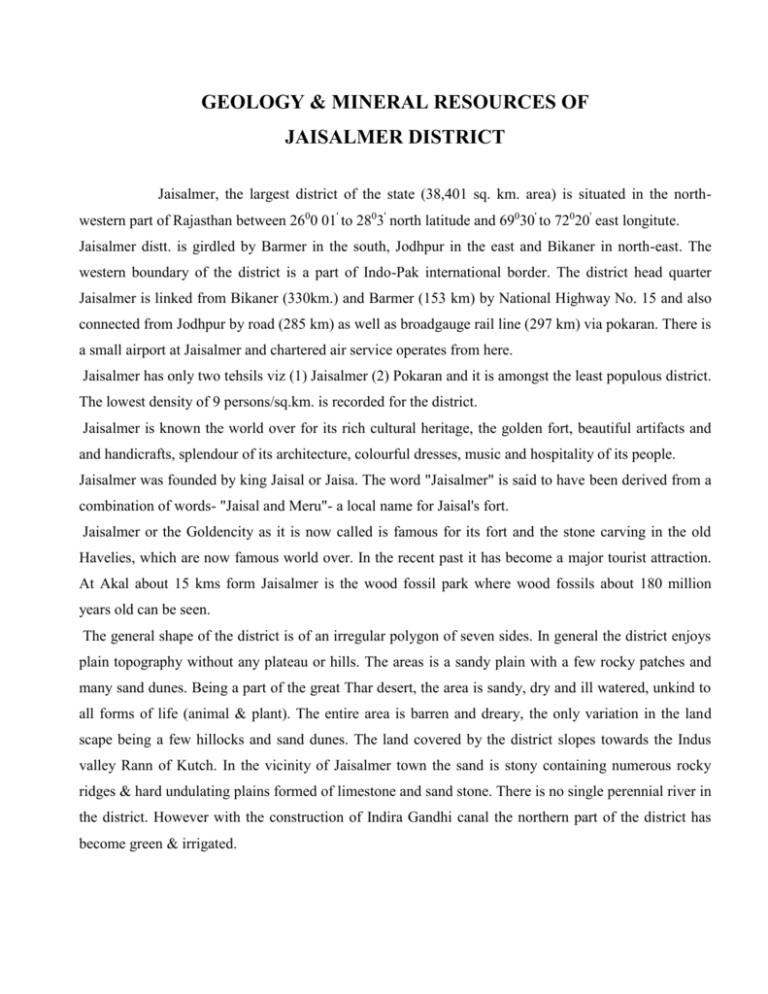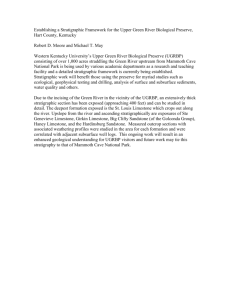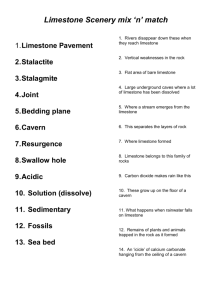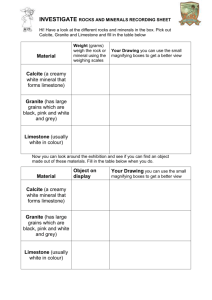GEOLOGY & MINERAL RESOURCES OF JAISALMER DISTRICT
advertisement

GEOLOGY & MINERAL RESOURCES OF JAISALMER DISTRICT Jaisalmer, the largest district of the state (38,401 sq. km. area) is situated in the northwestern part of Rajasthan between 2600 01' to 2803' north latitude and 69030' to 72020' east longitute. Jaisalmer distt. is girdled by Barmer in the south, Jodhpur in the east and Bikaner in north-east. The western boundary of the district is a part of Indo-Pak international border. The district head quarter Jaisalmer is linked from Bikaner (330km.) and Barmer (153 km) by National Highway No. 15 and also connected from Jodhpur by road (285 km) as well as broadgauge rail line (297 km) via pokaran. There is a small airport at Jaisalmer and chartered air service operates from here. Jaisalmer has only two tehsils viz (1) Jaisalmer (2) Pokaran and it is amongst the least populous district. The lowest density of 9 persons/sq.km. is recorded for the district. Jaisalmer is known the world over for its rich cultural heritage, the golden fort, beautiful artifacts and and handicrafts, splendour of its architecture, colourful dresses, music and hospitality of its people. Jaisalmer was founded by king Jaisal or Jaisa. The word "Jaisalmer" is said to have been derived from a combination of words- "Jaisal and Meru"- a local name for Jaisal's fort. Jaisalmer or the Goldencity as it is now called is famous for its fort and the stone carving in the old Havelies, which are now famous world over. In the recent past it has become a major tourist attraction. At Akal about 15 kms form Jaisalmer is the wood fossil park where wood fossils about 180 million years old can be seen. The general shape of the district is of an irregular polygon of seven sides. In general the district enjoys plain topography without any plateau or hills. The areas is a sandy plain with a few rocky patches and many sand dunes. Being a part of the great Thar desert, the area is sandy, dry and ill watered, unkind to all forms of life (animal & plant). The entire area is barren and dreary, the only variation in the land scape being a few hillocks and sand dunes. The land covered by the district slopes towards the Indus valley Rann of Kutch. In the vicinity of Jaisalmer town the sand is stony containing numerous rocky ridges & hard undulating plains formed of limestone and sand stone. There is no single perennial river in the district. However with the construction of Indira Gandhi canal the northern part of the district has become green & irrigated. The water table in The district is very deep in absence of perennial streams. The depth varies form 38 to 46 mts. some ground water potential areas have been identified in different formations where tubewells can be drilled. Geology Jaisalmer basin defined as NW slope of Indian peninsular shield which deepens Mari, Sui, and Quetta in Pakistan. Jaisalmer basin is one of the largest basins of India which encompasses an area of 30,000 sq. kms. It is bounded in the north by the sub- surface Delhi-Sargodha ridge and to the east by western flank of Aravalli mountain, to the south by two prominent uplifted blocks viz the Birmania- Barmer, Nagar, Parkar, Arch and the Saurasthra Peninsula. The basement rocks are the Metamorphites, Granites, and Rhyolites which are exposed near Birmania. they are unconformably overlain by dolomitic limestone, shale and sandstone of the Marwar Supergroup. Resting over these with unconformity are the Jurassic rocks made up of the Lathi formation (sandstone, grit and veriegated shales with plant fossils), Jaisalmar formation (predominantly fossiliferous limestone), Baisakhi formation (Siltstone, Shale and Sandstone with intercalations of gypseous and bentonitic clays represent first marine transgression) and Bedesar formation (sandstone, limestone and shales). These are followed by rocks of the Cretaceous system represented by fossiliferous limestone and feldspathic sandstone and grit. (Habur formation represents second marine transgression on the surface during cretaceous while in the subsurface this this is represented by the Goru and the Parh formation). Lower to middle Palaeocene represented by Sanu formation which consists of unconsolidated,highly current bedded reddish, gluconitic sandstone and silty sandstone. Upper Palaeocene to lower Eocene represented by Khuiala formation consists of limestone bouldary bedded, fossiliferous Limestone, clays and shales, The Khuiala limestone (Yoresian) having a total thickness of 100m. overlains the sonu sandstone is underlain by the Bandha limestone (Lutetian) of 75m. compacted thickness. This forms the close of the sedimentary cycle in Jaisalmer Basin. The Sanu formation (Lower to Middle palaeocene) represents regression of the sea but the upper part of Sanu and subsequent Khuiala (Upper Palaeocene to Yoresian) and Bandha (Lutetion) formation represent the third marine transgression. There after marine conditions appear to have completely receded from the Jaisalmer basin. Thus Mesozoic and tertiary sequences in the basin represent a typical shelf zone sedimentation of orthoquartzite-limestone association resting on a peneplained Precambrian surface. the Lathi, Jaisalmer, Baisakhi-Bedesar, Parihar, Ukra and Abur beds respectively are correlatable to Patcham, Vhari, Katrol Umia and of Kutch shelf. A generalised stratigraphic succession of the various lithounits occurring in Jaisalmer basin is as follows: Age Formation Lithounits Sub-Recent Secondary soil and pebbles Aeolian Sand and Kankar Late Pleistocene Glacial deposit Glacial pebbles Upper and Mid Eocene Bandha formation Gypseferous, sub bentonite shales, marls, foramineferal limestone.(Bandah,Joga, Bakri, Tebba, Habib) Lower Eocene to Khuiala formation Upper Palaecene Hard compact fossiliferous Lst, chalkyk Lst, shales fullers earth, clays. (Hingota teh Takkar). Palaeocene Sanu formation Sandstone, shales, siltstone, , Ironstone.(Khuiaia Khimsar, Khinaya) South of Sanu village, Shera Lr. to Mid Cretaceous Habur formation Parihar formation Friable, ferruginous and calcarious sandstone quartzite (Habur, Pasawar) Upper Jurassic Bedesar formation Interbedded, hard, ferruginous, compact sand stone (Bedesar, Mokal) Middle Jurassic Baisakhi formation Dark shale, argillaceous Sst., silt stone, (Baisakhi, Rupsi) Lower Jurassic Lathi formation Sandstone, gravel (Ulthe, Odanea) Pre Cambrian Malani Igneous Suite Rhyolites .. MINERALS OF JAISALMER DISTRICT Jaisalmer distt. is renowned for its mineral wealth. It occupies a significant position on the mineral map of the state. It possesses a wide range of mineral resources and offers considerable potential for further. With the discovery of steel grade limestone and cement grade limestone the district has come into limelight and already six areas have been offered for major cement plants. Jaisalmer has also shown positive evidence of Hydro carbon accumulation (Natural Gas). The description of minerals occuring in the district is given below: GYPSUM Gypsum is hydrated sulphate of calcium CaSO 4' 2HzO. Gypsum occurs mainly as thick, stratified sedimentary beds or lenses, horizontal or gently inclined, varying from a few feet up to 8-10 feet in thickness. In Jaisaimer district gypsum deposits are reported in Mohangarh, Phalsund, Ghandan, Nokh, Nachana,Satta, Sundra and Lakha Khadar areas, Most of the gypsum deposit of the district are just surface deposits and are won by open cast mining method. In several mines, mining is done manually as the gypsum beds are not of uniform thickness. Five leases for gypsum exist in the district & mining is being done by Mis. FCI & M/s. RSMDC Ltd. . SELENITE Selenite is a crystalline variety of gypsum forming transparent foliated plates. It occurs as single or twined crystals and is used in manufacture of plaster of Paris. It occurs at Mohangarh, Hamir-wali-Dhani, Lakhera, Ramgarh, Bandha, Biprasar, Khuiala and Rupsi. Selenite crystals occur embeded in matrix of marly clay. In Khuiala it is found in nala section near Ubrakha-ki-Dhani intercalaled with bentonite having thickness about 5-7 cms. BENTONITE It is a naturally occurring clay of great commercial importance possessing j$erent bleaching properties. The Bentonite is chiefly composed of about 75% of montmorillonite, the rest being kaolinite, attapalgite, illite, chlorite, quartz, and feldspar. Occurrences of bentonite are reported near Khuiala, Mandha, Khuri, Habur, Mandai, Ramgarh villages. The deposits of Khuiala and Khuri prospected by the department of Mines & Geology, are of medium grade, the reserves estimated are 2 M.T. and 1 M.T. respectively. The Bentonite of the district is mainly of nonswelling type and has a lower ratio of soda to lime. It is not suitable for oil well drilling because of plastic viscosity. FULLERS EARTH It is variety of non plastic montmorillonite clay which has a property to decolourize oil, fats and grease. It is also used for washing hairs, Its occurrences are associated with Khuiala limestone at Khuiala and Mandha areas of the distt. Near Mandha it is 0.60 to 2.75 mts. thickness and a reserve of 30 thousand tonnes is estimated. Other occurrences are. reported near Ramgarh, Sanu and Dhol-ki-Dungari. WHITE CLAYS It is interstratified with sandstone of Lathi group at following localities Kita : At Kita the clay occurs about 4 kms. NE of the village where two bands having average thickness of apout 1 mt are reported and about 4 thousand tonnes reserve, estimated. Devikot : At Devikot clay occurs at 2 km. SW of the village with thiCkness 1 mt. & having 29 thousand tonnes reserve. The tests indicate that the clays are refractory in nature and having low shrinkage but are not suitable for use in pottery as they develop cracks on firing. SILICEOUS EARTH The siliceous earth also known as siliceous ooze (Diatomite) occurs in Jaisalmer district, at Dharivi, Khurd, Mandai, Sajeet Mimbla . It occurs as thin bands grading into bentonite. Siliceous earth is composed of cristobalite silica with minor montmorillonite, quartz and trace minerals. Siliceous earth is regarded as an excellent filtering aid for colloidal solid solution like Beverage, Fruit juice Syrups, Oils (Vegitable oils & Mineral oil), Antibiotic products, water treatment to remove amoebic cysts and blood fluke larves, drugs and other pharmaceuticals items are all filtered through silicious earth. It can be used as filler in paper, rubber, paints and plastic, as carrier of disinfectant like D.D.T. as admixture in pozzolana cement, Due to low thermal conductivity it is used for the manufacture of insulating bricks and as an anticaking agent in fertilizers, About 1.2 MT reserves have been assessed from this district. GLASS SAND The deposits are reported from Lathi, Devikot and Pithal in Jaisalmer distt. The Lathi sandstone. occurring near Lathi is pure white in colour and is spread over an area of about 20 sq. km. This sandstone has given silica sand due to weathring. The quarriable section exposed workable Glass sand upto 1.5 mts. to 2.5 mt. in depth has analysed SiO2 92 to 95% , Al2O3 1.2 to 3.99%,Fe2O3.63 to 1.29% and MgO and TiO2 as nil, It could be utilised for the manufacture of Bottle Glass. About 14.4 M.T. reserves have been assessed from this district. DOLOMITIC CLAY White fine grained dolomitic clay having good plasticity is found near village Chacha and, Udhaniya. The clay is quite useful as filler in paper, textiles and paint industry. YELLOW OCHRE Small deposits of Yellow Ochre occur near Mandai with thickness of the bed varying from 0.25 to 0.39 mts. The over burden is 2 to 5 mts. thick. It is useful for painting of houses. ROCK PHOSPHATE Phosphorite or rock phosphate associated with limestone, chert, black shales and sandstone has been located at Birmania and Fatehgarh. In Birmania phosphorite horizon extends up to 4 km. towards Kohra in the south having 3 mt. thickness. The phosphate rocks at Birmania are calcarious or arenaceous. 4.34 million tonnes reserves were estimated with P2O5 content ranging from 10-11 % At Fatehgarh, a 1-4 mt thick phosphorite horizon comprising oolites, pellets, coprolites, and replace shells of fossils, is traced for about 12 kms. along the strike. The phosphorite horizon is found interbeded with limestone. The P2O5 content ranges from 5% to 15%. Phosphate nodules were reported in the Baisakhi shales near Rupsi and Nibh Doongar. Analysis shows that smaller modules of this area contain PPs from 22% -27%. Mis. RS.M.D.C. Ltd. has been granted lease for mining in this area. JASPAR It is a cryptocrystaline variety of Quartz and occur near village Chacha, Ramdevera & Pokaran. The colour is red to yellow. It is used as an abrassive for preparation of emery stone and emery paper. VOLCANIC ASH Volcanic ash deposits are located near village Phalsund, Dantal, Fulasar, Swami-ji-ki-Dhani etc. It is light green to yellowish in colour. A sample tested in the CGCRI, Jadavpur indicated that at the temp. of 1300°C it changes to molten glass which can be used for manufacture of various type of glass wares, glass sheets etc. YELLOW MARBLE Jaisalmer is popularly known as golden city because fortress and residential buildings are build of yellow fine grained limestone. This limestone is used as marble by cutting and polishing it as tiles. At present it is being quarried near Mool sagar, Amarsagar, Chundi, Bhagata, Wajron ki Dhani and Cipla etc. Yellow marble is a speciallity of Jaisalmer and its demand is rising day by day in India and abroad. Yellow marble belongs to Jaisalmer formation and forms ridges, mounds and hillock. It forms the top unit and at places where the bed is massive and 1-2 mt thick, the block mining is being done. STEEL GRADE LIMESTONE The occurrance of low silica high CaO limestone in Jaisalmer District was first identified in the year 1974. The chemical analysis of four samples indicated that the CaO content ranges from 53.04% to 54.04%, MgO from 0.71 to 1.00% and insolubles from 0.67% to 0.94%. The state department of Mines & Geology started exploration in 1983-84 by driling and proved large reserves of SMS grade linestone. Investigations are still continued. Limestone occures near Sanu Habur, Khuiala, Hemaki-dhani, Nibya, Jethaa, Joshiowala gaon etc. villages over an extent of about 100kms. with awidth varying from 1 to 9 kms. in maximum encompassing about 600 sq. km. area. The belt extends in patches from south of Ramgarh to south of Sanu in N-S direction and Khuiala in SW to Rata Madha in NW. SMS Grade limestone occures on top having thickness of 1-3 mts. followed by chalky limestone which is of cement grade. The high grade limestone also occurs in Jaisalmer district. The chemical analysis indicates CaO content from 53-54% Si02 1-2%. Total 585 MT reserves of SMS grade lime stone have been assessed up to 1996-97. Mining of SMS grade line stone is being done in public sector by M/S RSMML & M/s RSMDC Ltd. Chemical grade line stone is also found in Jaisalmer district near Jethwai etc and about 233.33 MT reserves have been assessed. CEMENT GRADE LIMESTONE Jaisalmer is endowed with high reserves of cement grade limestone. Limestone occuring in Jaisalmer formation is yellowish, massive & occurs near Jaisalmer, South of Moolsagar, Hamera, Amarsagar etc. In the Khuiala formation SMS grade limestone is found at top followed by cement grade limestone. It is also called as chalky limestone. It is moderately hard, white to light yellowish in colour earthy, lumpy & fossilierous. The analysis of this lime stone indicated CaO 43-45% Si0211 % & MgO less then 2%. Investigations have been carried out by state department of Mines & Geology for cement grade limestone and so far 2018.94 MT reserves have been proved. Six blocks have been identified for setting up of major cement plants. The details are given below: S No. Name of blocks Area Geological reserves (In million tones) SMS Cement 1. Minyan ki Dhani 7.6889 km. 74.415 355.13 2.. Tulsi Ram ki Dhani 7.25 km. 50.94 209.75 3. Khinya black-l 7.00 km. 24.52 277.11 4. Khinya block-2 7.00 km. 1.8. 276.00 5. Khinya black-3 7.00 km. 36.69 218.85 6. Tulsi Ram ki Dhani-25.00 km. 14.46 137.39 These areas have been notified for inviting applications.Aproval of Govt. of India has been recivedfor three major cement plants of MI s Sorastra Cement near Khiya Khinsar Block 1, Mis Century Cement near village Miyon ki Dhani & Mis Decon Ind. Ltd. Khiya Khinsar Block 2. Proposals of Mis Ansal Properties & Ind. Ltd. near village Tulsiram ki Dhaili (Main Blockhasbeen sent for aproval of Govt. of India. GRANITE Jalore Siwana Grariite Suitable for block mining is exposed near Lakha, Randha, Mehron-ki-Dhani, Madli, Kohera Department of Mines & Geology has carried out investigation in above areas and availability of blockoble granite is found over 100 sq.mt. area. This granite is medium grained brick red in colour occuing as scattered outcrop in plains. MINERAL FUEL Attempts to explore hydrocarbons in Rajasthan dates back to 1956. ONGC has been carrying out investigation for oil and gas since 1962. In 1981 under a major policy decesion, the Govt. of India assigned a high priority to Rajasthan and in 1982 ONGC & Oil India Ltd. were allowed 14000 & 28000 sq.km. area respectively for exploration. The Jaisalmer basin has thick sedementary secton with positive evidence of hydrocarbon accumulation. As a result of geo scientific exploration nine gas fields have been identified by ONGC & OIL near Manhar Tibba, Ghoataru, Bakhri, Khartor, Bantua, Tanot & Ramgarh. Agas based power plant of 35 MW capacity has been set up in Ramgarh and is producing electricity. MINERAL BASED INDUSTRIES Industrially Jaisalmer is considered to be a no industries district. As such government provides help & subsidy to entrepreneurs putting industries in this district. The main minerals which have scope for establishing mineral based industries are high and cement grade limestone, marble, sandstone, siliceous earth and natural gas etc. Vast resources of cement grade limestone exist in the area and six areas have already been notitied for setting up of major cement plants. Availability of chemical & high grade limestone paves way for setting up of chemical industries. Natural gas has been stuck in the district and one gas based power plant has started production near Ramgarh. There is further scope for setting up of such plants. Jaisalmer is endowed with availability of solar radiation through out the year and solar power plants can also be set up. Yellow marble and sand stone of Jaisalmer is world famous and cutting & polishing industries can be established based on these deposits. At present there is one Plaster of Paris plant, twelve marble cutting & polishing units, one marble decorative article industry and twenty two crushers in the district. There is scope for setting up of glass and ceramic industry. Gypsum of the district can be used for local manufacture of sulfuric acid, bricks and wall boards. MINERAL ADMINSTRATION There is an office of Asstt. Mining Engineer at Jaisalmer which looks after the mineral adminstration. The geological work is carried out by Superintending Geologist, Jaisalmer. During the year 1997-98, 3 projects have been proposed for investigation. S.N o. Minerals No. of Lease Production (thous. Tonnes) Sale value (thous. Rs.) Revenue thous. Rs.) Major Minerals 1 2 3 4 5 6 7 8 Ochers Dolomite Siliceous Earth Jaspar Gypsum Limestone(SMS Grade) Rock Phosphate Oil & Gas 1 1 4 1 5 0.02 0.18 7.81 0.15 199.26 1.52 16.8 1114.4 36.25 24816.09 2.91 2.91 68.63 4.23 4010.64 2 988.89 509877.66 238218 1 - - - 40 3460.28 Minor Minerals 9 10 11 12 13 14 15 LimestoneBurnin g) Marble (Block) (Khanda) Sandstone Masonary Stone Maurram Brick Earth Bajri 1 0.28 43.28 19.17 49 29.17 1.38 22.69 998.07 103.15 442.94 169.16 13505 60.4 3094.2 24951.75 2578.75 11073.5 4225 3021.27 39 59 - 615.71 379.21 - 16 17 18 Granite Bentonite Slatstone 1 1 - - - 22.5 22.5 6.25 Misc. 1 2 3 PWD Contracts Unauthorised Mining Others Total 20118.27 113.42 7114.68 67233.2 1. Detailed exploration for cement grade & SMS grade limestone in Rata area, Teh & Distt Jaisalmer. 2. Detailed exploration for cement grade limestone Kabirbasti area, distt. Jaisahner. 3. Regional Mineral swvey for clays/ occhre in Boa, Nadai area and for gypsum in Nachna area distt. Jaisalmer. STATISTICAL INFORMATION OF JAISALMER DISTRICT FOR 1996-97 Unpublished Geological Reports of Jaisalmer District (A) Geological Survey of India & Others. Kumar, V & Sahiwala, N.K.; 1981-82 - A report on the evaluation of lime stone resources in AbamakaPar Sam- Go- Jerira - Chaunra Bhaiyanka - Biprasar Area. Chawde, M.P. & Kumar, B.; 1987-88 - Systemetic geological mapping in parts of Jaisalmer district. Khokhawat, L.S. & Bohra, S.K.; 1987-88 - Systemetic geological mapping in parts of Barmer & Jaisalmer district. Sawarkar, AR ; 1981-82 - Report on the Evaluation of the mesozoic - cenozoic boundary in the parts of Western Rajasthan. . Kumar, V; 1977-78 - Report on the preliminary appraisal of lime stone deposits around Khuiala. Kumar, V ; 1980-81 - Report on the lime stone investigation in Sanu- Ramgarh, Tulsiram-ki-Dhani & Khinsar Mandha area. Shrivastava, RN. ; 1979-80 - Quaternary geological and geomorphological studies in parts of Jaisalmer and Jodhpur districts. Ray, I. & Chawdhary, P.K.; 1980-81 - Preliminary investigation of Benotinite clays in Khinya Mandha Joga Tanasar areas Kumar, V ; 1979-80 - Report on the investigaion of limestone deposite around Shyambar Talai, Alamorali Dhani, Khaiala, Hingola and Bandha area Sen, AK.; 1977-78 - Report on geological mapping in parts of Jaisalmer district. Laul, VP. ; 1977-78 - Report on the systemetic geological mapping of noka-Kandiyala area. Malhotra, AK. ; 1986-87 - Report on the reconnaissance for phosphorite in the Abur formation. Kumar, V ; 1982-83 - Report on the geological mapping in parts of Jaisalmer & Barmer district. Bhatnagar, P.s.; 1980-81 - Report on the geological mapping in parts of Jodhpur and Jaisalmer district. Laul, V.P. ; 1981-82 - Report on the geological mapping in parts of Jaisalmer and Barmer districts. Sharma, VK. ; 1987-88 - Quarternary geological studies in parts of Jaisalmer and Jodhpur districts. Sharma VK. ; 1987-88 - Quarternary geological studies in parts of Jaisalmer and Jodhpur districts. Kumar, V & Sahiwala, N.K. - A report on lime stone investigation with special reference to Khuiala limestone. National Counsil for cement & Building material - Report on suitability of chalky lime stone in cement manufacture. Narayanan, K. - Geology of Jaisalmer Chattopadhyay, N. & Banerjee, S.N. - Report on the occurrences of gypsite in parts of Jaisalmer district. Deshmukh, G.P. & Bhushan,B.; 1966-67 - A preliminary report on the phosphorite deposite near Fatahgarh. Deshmukh, G.P. - Report on the exploration drilling for phosphorite. Misra, S.P. ; 1974-75 - Bentonite investigations in Shes - Kalan - Bisu block in Barmer district & preliminary appraisal of glass-sand occurrencies in Barmer and Jaisalmer districts. Bhushan, B.; 1973-74 - Geological mapping of the Malani Igneous suite & study of its Petrography Geochemistry & possible mineral potential. Madhava Rao, M.R,; 1976-77 - Report on geological mapping inParts of Jaisalmer district. (B) Department of Mines & Geology, Udaipur. DMG Udaipur - Report on the laboratory scale study of Jaisalmer limestone for the production of precipited calcium carbonate. Shanna, A.K - Production of precipited calcium carbonate from Jaisalmer limestone. Bhargava, KD., Mehta, R.K ; 1967-68 - Preliminary geological study of the Jaisalmer yellow limestone. Bhargava, KD. & Rathore, B.R ; 1970-71 - Investigation of yellow limestone and other economic minerals in Jaisalmer area. Keshwani, KB.; 1974 - Preliminary geological study of Jaisalmer yellow limestone. Rampuria, T.e.; 1974-75 - Prospecting for selenite in Budha, Ekil, Beprasas, Ramgarh area. Bhargava, S.e.; 1975-76 - Prospecting for bentonite in Banner and Jaisalmer districts. Bhargava, S.e.; 1975-76 Prospecting for selenite in Jaisalmer district. Bhargava, S.e.; 1972-72 & 1977-78 - Investigation for silica sand deposit near village Lathi. Babel, G.L. ; 1977-78 - Investigation of dolomite & clay in Jaisalmer district. Babel, G.L.; 1977-78 - Reconnaissance Survey around Sankara area. Babel, G.L.; 1976-77 - Investigation of volcanic ash in Jaisalmer district. Singh, S.P. ; 1978-79 - Annual progress report of the reconnaissance survey of economic minerals in Jaisalmer district. Babel, G.L. ; 1979-80 - Preliminary report of chemical grade limestone in Jaisalmer district. Rai, S.C.. ; 1978-79 - Search for clay and other economic minerals in Jaisalmer district. Shanna, J.P.S.; - A report of the work done near Amar Sagar, Bada Bag for cement grade lime stone. Shanna, J .P.& Vijayvergia, RP.; 1983-84 - Annual progress report of cement & chemical grade limestone near village Sanu, Khuiala. Ali, Q. & Mehta, H.S. ; 1984 - Acid activation of fuller's earth encountered in bore hole No. JSL-5 near Sanu. Bhargava, S.e.; 1972-73 - Investigation report of silica sand deposit near village Lathi. Shanna, J.P. & Singh, S.P.; 1983-84 - Reconnaissance for limestone, phosphate and other economic minerals near Kala Dungar, Baisakhi & Pupsi. Sr. Geologist, Banner - A note on mineral resources of Jaisalmer district. Shanna, J.P. & Gupta, L.P.; 1986 - Investigation of lime stone deposit near Sanu, Habur & Khuila. Bhattacharya, B.c., Mehta, H.S.; 1986-87 - Levigation study of Chalky limestone from Jaisalmer district. Sharma, J.P. & Sukhwal, 0.5.; 1985-86 - Reconnaissance for economic minerals with special reference to potash beaming gluconiticshale in parts of Jaisalmer and Banner districts. Shanna, J.P. & Singh, S./P. ; 1986-87 - Prospecting for silica sand near village Mokala. Ravi Dayal & Singh, S.P. ; 1988-89 - Reconnaissance for phosphorite nodules, S.M.s. grade lime stone near Kanoi, Kesua & Salkha areas. Ravi Dayal & Singh, S.P. ; 1988-89 - Reconnaissance for fluorite, barytes & dolomite etc. around Pokaran. Dashora, RS. and Dhaka, B.S.; 1991-92 - Investigation report on'S.M.S. grade limestone deposit in Dhaleki Dungri-Unrai, Mohammed ki Dhani & Khuiala area. Dashora, RS. & Dubey, S. ; 1993-94 - Exploration for cement grade limestone in Tulsiram-ki-Dhani area (A-Block). Danish, H.A.; 1991-92 - Report on the geophysical investigation for Rock phosphate in Fatehgarh. Birmania. Sharma, J.P.; 1987-88 - Reconnaissance for gypsum, phosphorite and cement grade limestone near village Hamira & Kanod. Ravi Dayal & Paliwal, RS.; 1989-90 Preliminary investigation for limestone around village Baisakni, Baramsar, Pohar, Jethwai and North-East of Jaisalmer. Ravi Dayal & Rathor, B.5.; 1990-92 - A report on geological investigation for high grade limestone in Jurassic formation of Jaisalmer. Ravi Dayal & Singh, S.P.; 1988-89 - Investigation for S.M.S. grade lime stone around village Mandha. Bafna, P.C. & Rathore, B.S.; 1990- Prospecting report of S.M.S. grade limestone deposit of the area alloted to M/ s. RS.M.M. Ltd. near village Sanu. Bafna, P.C.; 1989-90 - Investigation for S.M.5. grade limestone in Sanu area. Shekhawat, P.S.; 1982-83 & 1990-91- Report on reconnaissance around Chandan - Dholiya area. Ravi Dayal & Singh,S.P.; 1989-90 - Reconnaissance for phosphorite nodules & S.M.S. grade limestone near village Kanoi and Kesua. Khabya, N.K.; 1989-90 - Reconnaissance for phosphorite in Birmania area. Dashora, RS. and Dhaka, B.S.; 1987-90 - Exploration of S.M.S. grade limestone in the area North of Sanu, North of Hema & South of Hema-ki-Dhanivillage, Tehsil Ramgarh. Augwani, M.U.; Kothari, M.S.;Sukhwal, K.L. Dhaka, B.S.; 1992 - Exploration for cement grade limestone in Minyo-ki-Dhani area near Ramgarh.








